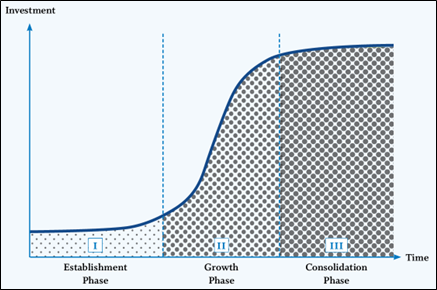6.5 Action and investment Plans
Strategies and Actions
Both strategies and actions are investment plans. However, Beer et al. (2013) note that there is a considerable difference between countries regarding what is included in a strategy document and what is included in action plans. It notes that one key point of difference is the level of detail on specific measures. Some include greater detail within the strategy, some leave detail to the action plans, while others provide detail for the initial period of the strategy, (e.g. the first two years) but rely on action plans (reviewed perhaps every two years) to supply detail for later stages of the strategy. It concludes that there is no answer as to which is the best approach on this issue. The important point is that the strategy should allow enough flexibility to address any specific problems that arise as the strategy unfolds (for instance, in light of new information on potential problem groups), shifts in the political environment (including changes in funding or priorities), or with the emergence of new techniques to address risk. The action plan, on the other hand, should provide detailed descriptions of what will be accomplished for each action, along with a timetable, costs and expected benefits, while having the following characteristics:
- Actions should be realistic (taking account of financial and other types of constraints).
- Actions should be selected in all key areas of road safety (balanced program).
- Priority should be given to measures which have been shown to be cost-effective.
TARGET-SETTING TIMEFRAMES
Investment strategies and actions need to be adopted to support improved road safety performance and the achievement of targets – in the short-term (one to three years), the medium-term (three to ten years) as well as in the long-term (beyond ten years). For LMICs, steady progress through demonstration projects is the recommended option for the short-term, with or without an aspirational (notional) short-term target.
For both LMICs and HICs, thoughtful investment plans and strategies will be essential to achieve steady progress towards medium-term targets and eventually to move further towards the ultimate long-term goal (see the Chapter 3. Road Safety Management System). An understanding of the relationship between investment phases and strategy timeframes is necessary.

SOURCE: ADAPTED FROM MULDER AND WEGMAN,1999
The establishment (short-term timeframe) phase of road safety investment planning focuses on building core capacity to enable effective targeted road safety performance to begin and grow. The two key purposes of activity in this phase should be:
- Setting up management and coordination arrangements for road safety.
- Developing a performance management culture.
Tasks to be accomplished in this phase may include the development and implementation of necessary data systems, tools and guidelines and strengthened legislation to be in place in time to support later implementation phases.
In the growth (medium-term timeframe) investment phase, key priorities are:
- Developing a robust performance management framework for all agencies with targeted safety programmes.
- Implementation of recommended changes from policy reviews undertaken in the establishment phase.
- Adequate funding.
In the consolidation (long-term) investment phase, key priorities are:
- Ensuring the performance management framework has been established in regions and districts.
- Improvement of management and operational efficiency and effectiveness.
- Seeking opportunities for future safety innovations.
PRINCIPLES OF ACTION PLANS AND INVESTMENT PLANS
As stated above, action plans and investment plans can deal with different timeframes (short-term, medium-term, and long-term). However, a clear definition of some aspects is essential, as they are important for the success of the plans in any timescale:
- Targets should be linked with defined timelines in which they should be achieved.
- Adequate funding has to be ensured.
- Accountabilities have to be defined.
- An effective decision making should be applied and consultation arrangements to support the implementation of measures.
The challenge in LMICs is to achieve the preconditions necessary to deliver the planned outcomes. This usually requires years of sustained effort. Road safety improvement is a continuous process requiring ongoing commitment.






